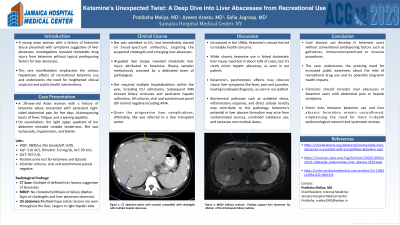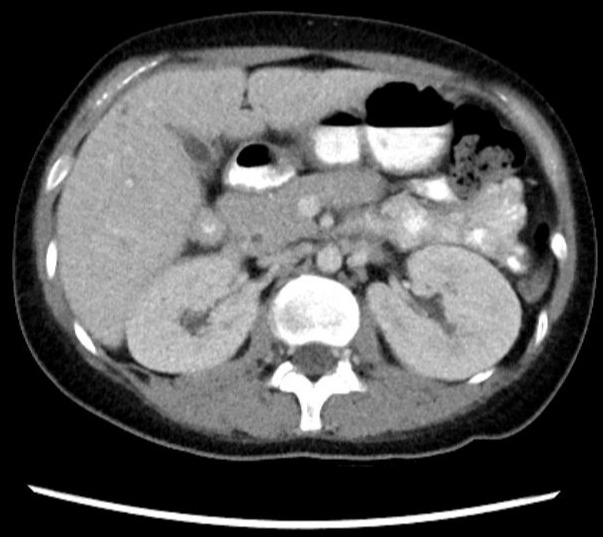Tuesday Poster Session
Category: Liver
P3882 - Payback for the Recreation: An Interesting Case of Ketamine-Related Liver Abscesses
Tuesday, October 24, 2023
10:30 AM - 4:00 PM PT
Location: Exhibit Hall

Has Audio

Pratiksha Moliya, MD
Jamaica Hospital Medical Center
Edison, NJ
Presenting Author(s)
Pratiksha Moliya, MD1, Azeem Arastu, MD2
1Jamaica Hospital Medical Center, Edison, NJ; 2Jamaica Hospital Medical Center, New York, NY
Introduction: Ketamine is a popular drug due to its dissociative effects. However, its severe liver-related consequences undermine public health. We present a rare case of Ketamine-related liver abscess.
Case Description/Methods: A 28-year-old Asian woman, a known ketamine abuser, presented with right abdominal pain and fever for five days, accompanied by fatigue and decreased appetite. Clinical Examination revealed tenderness in the right upper quadrant. She was tachycardic, hypotensive, and febrile. Labs showed a WBC count of 9800/uL without bands or left shift, ALP 952 IU/L, total bilirubin 4.0 mg/dL, and ALT 49 IU/L. All cultures, viral and autoimmune workups returned negative except for Ketamine in her urine. A CT scan revealed multiple ill-defined liver lesions suggesting potential liver abscesses. She received broad-spectrum antibiotics for suspected acute cholangitis and liver abscesses. An MRCP showed no evidence of choledocholithiasis or biliary dilation. IR-guided liver biopsy was done, which revealed cholestatic drug injury attributed to Ketamine. She was admitted a month later with similar complaints. Repeat CT demonstrated numerous evolving liver abscesses, while MRCP showed cholangitis alongside the abscesses. She required multiple hospitalizations in the year, including ICU admission. Subsequent MRI showed biliary strictures and suspected hepatic collections. Ultimately, She was referred to a liver transplant center.
Discussion: Ketamine is often abused recreationally, especially in Asian populations.AlthoughKetamine-associated cholestatic liver injury is reported in about 10% of cases, it's rarely associated with hepatic abscesses, as seen in our patient. Symptoms such as right upper quadrant pain, fever, and jaundice, may be masked by the drug's psychotropic effects, leading to delayed diagnosis and treatment, as might be the case with this patient. Our patient demonstrated liver abscesses without predisposing factors like gallstones, immunodeficiency, or invasive procedures. This highlights the need for understanding Ketamine-related hepatotoxicity and abscess formation mechanisms. Biochemical pathways such as oxidative stress, inflammatory response, and direct cellular toxicity may contribute to this pathology. However, the exact mechanisms remain unclear. Clinicians should consider liver abscesses in Ketamine users with abdominal pain or hepatic symptoms. This case highlights the need for public health initiatives against substance abuse to mitigate such health complications.

Disclosures:
Pratiksha Moliya, MD1, Azeem Arastu, MD2. P3882 - Payback for the Recreation: An Interesting Case of Ketamine-Related Liver Abscesses, ACG 2023 Annual Scientific Meeting Abstracts. Vancouver, BC, Canada: American College of Gastroenterology.
1Jamaica Hospital Medical Center, Edison, NJ; 2Jamaica Hospital Medical Center, New York, NY
Introduction: Ketamine is a popular drug due to its dissociative effects. However, its severe liver-related consequences undermine public health. We present a rare case of Ketamine-related liver abscess.
Case Description/Methods: A 28-year-old Asian woman, a known ketamine abuser, presented with right abdominal pain and fever for five days, accompanied by fatigue and decreased appetite. Clinical Examination revealed tenderness in the right upper quadrant. She was tachycardic, hypotensive, and febrile. Labs showed a WBC count of 9800/uL without bands or left shift, ALP 952 IU/L, total bilirubin 4.0 mg/dL, and ALT 49 IU/L. All cultures, viral and autoimmune workups returned negative except for Ketamine in her urine. A CT scan revealed multiple ill-defined liver lesions suggesting potential liver abscesses. She received broad-spectrum antibiotics for suspected acute cholangitis and liver abscesses. An MRCP showed no evidence of choledocholithiasis or biliary dilation. IR-guided liver biopsy was done, which revealed cholestatic drug injury attributed to Ketamine. She was admitted a month later with similar complaints. Repeat CT demonstrated numerous evolving liver abscesses, while MRCP showed cholangitis alongside the abscesses. She required multiple hospitalizations in the year, including ICU admission. Subsequent MRI showed biliary strictures and suspected hepatic collections. Ultimately, She was referred to a liver transplant center.
Discussion: Ketamine is often abused recreationally, especially in Asian populations.AlthoughKetamine-associated cholestatic liver injury is reported in about 10% of cases, it's rarely associated with hepatic abscesses, as seen in our patient. Symptoms such as right upper quadrant pain, fever, and jaundice, may be masked by the drug's psychotropic effects, leading to delayed diagnosis and treatment, as might be the case with this patient. Our patient demonstrated liver abscesses without predisposing factors like gallstones, immunodeficiency, or invasive procedures. This highlights the need for understanding Ketamine-related hepatotoxicity and abscess formation mechanisms. Biochemical pathways such as oxidative stress, inflammatory response, and direct cellular toxicity may contribute to this pathology. However, the exact mechanisms remain unclear. Clinicians should consider liver abscesses in Ketamine users with abdominal pain or hepatic symptoms. This case highlights the need for public health initiatives against substance abuse to mitigate such health complications.

Figure: CT abdomen and pelvis without contrast showing liver abscesses
Disclosures:
Pratiksha Moliya indicated no relevant financial relationships.
Azeem Arastu indicated no relevant financial relationships.
Pratiksha Moliya, MD1, Azeem Arastu, MD2. P3882 - Payback for the Recreation: An Interesting Case of Ketamine-Related Liver Abscesses, ACG 2023 Annual Scientific Meeting Abstracts. Vancouver, BC, Canada: American College of Gastroenterology.
